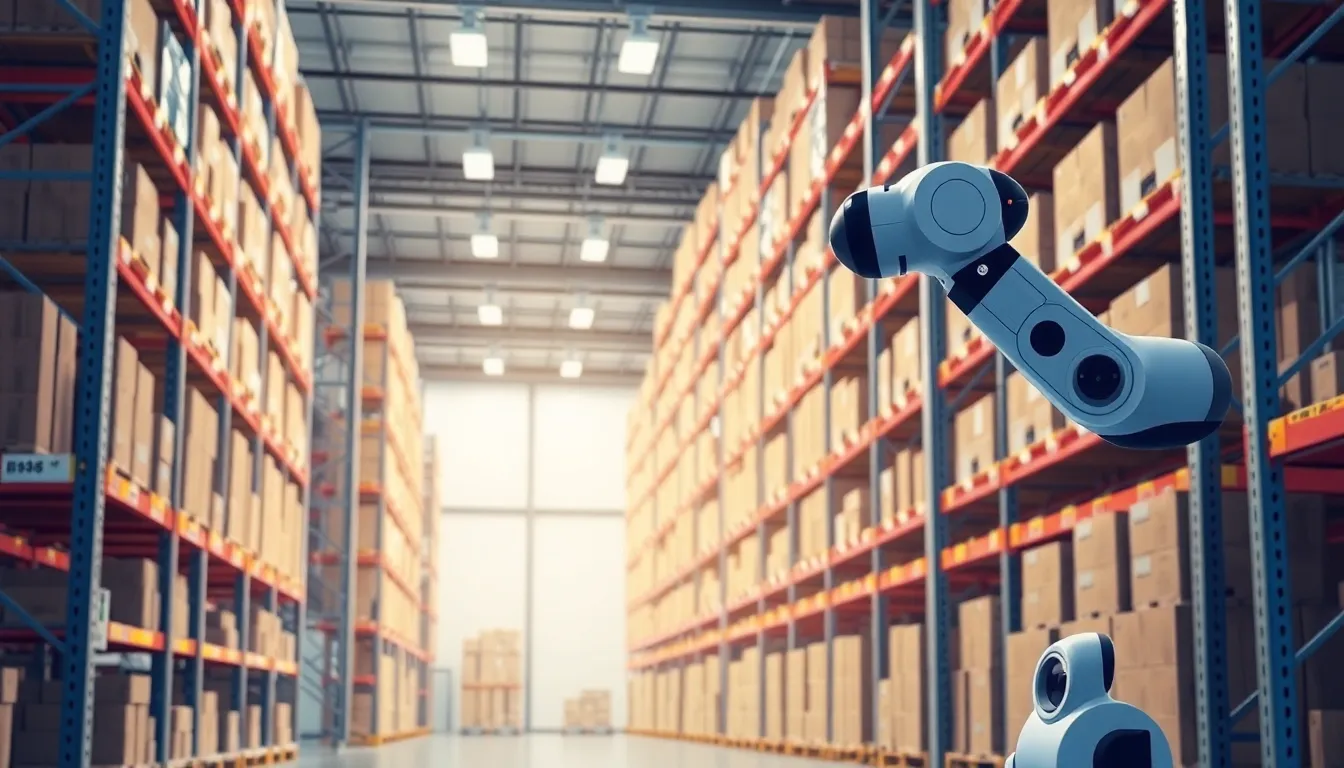Table of Contents
ToggleIn a world where supply chains are more tangled than a pair of earbuds in a pocket, emerging technologies are stepping in like a superhero with a cape. These innovations are not just saving the day; they’re revolutionizing how businesses operate. From blockchain to AI-driven analytics, the future of supply chain management is looking brighter than a neon sign at a midnight diner.
As companies scramble to keep up with consumer demands, these cutting-edge tools promise to streamline processes, enhance transparency, and boost efficiency. Imagine a supply chain that runs smoother than a well-oiled machine—now that’s something worth getting excited about! Buckle up as we explore the latest trends and technologies that are transforming the supply chain landscape, ensuring businesses stay ahead of the curve and maybe even have a little fun along the way.
Overview Of Emerging Supply Chain Technologies
Emerging technologies significantly reshape supply chain management. Blockchain enhances transparency through secure, decentralized ledgers. Artificial Intelligence optimizes operations by analyzing vast data sets to predict trends and streamline processes. Robotics automates repetitive tasks, increasing speed and accuracy in logistics and inventory management.
The Internet of Things (IoT) connects devices and monitors assets in real-time. Sensors track product conditions and locations, providing valuable data for informed decision-making. Cloud computing facilitates collaboration among supply chain partners, enabling seamless information sharing. Data analytics tools transform raw data into actionable insights, enhancing visibility across supply chains.
3D printing allows on-demand production, reducing inventory costs and lead times. Companies customize products closer to the point of demand, increasing responsiveness to market changes. Augmented reality supports warehouse operations through visual aids, improving efficiency in picking and packing tasks.
Drones offer innovative delivery solutions, particularly in hard-to-reach areas. They decrease delivery times and reduce transportation costs. Advanced technologies like machine learning enhance predictive maintenance, preventing equipment failures and minimizing downtime.
As businesses adopt these supply chain technologies, they gain a competitive edge. Continuous evolution in technology ensures adaptability to changing market needs, positioning firms for success. Keeping up with these advancements is crucial for organizations aiming to excel in dynamic environments.
Key Technologies Shaping the Future


Emerging technologies significantly influence supply chain operations, enhancing efficiency and responsiveness. Several key innovations stand at the forefront.
Artificial Intelligence and Machine Learning
Artificial intelligence (AI) and machine learning are revolutionizing supply chains by automating complex tasks. These technologies analyze vast datasets, providing insights that drive decision-making. Predictive analytics enables organizations to forecast demand accurately, reducing excess inventory. Operational efficiency increases as AI optimizes routes for transportation and logistics management. Machine learning algorithms continuously improve through data, adapting to market changes and consumer preferences over time.
Blockchain Technology
Blockchain technology enhances transparency and security in supply chain transactions. By utilizing decentralized ledgers, it allows for real-time tracking of goods, minimizing fraud risks. Stakeholders can access a single source of truth, streamlining verification processes. Smart contracts automate agreements, reducing paperwork and accelerating operations. As more companies implement blockchain, they foster trust among partners in the supply chain network.
Internet of Things (IoT)
The Internet of Things (IoT) connects devices and systems, facilitating real-time monitoring of assets throughout the supply chain. Sensors embedded in products track their location and condition, ensuring timely interventions when necessary. Data collected from IoT devices informs inventory management, enhancing stock accuracy. Increased visibility across the supply chain leads to faster response times and improved customer satisfaction. Organizations embracing IoT move toward smarter, more agile supply chains.
Robotics and Automation
Robotics and automation streamline repetitive tasks within supply chain operations. Automated systems increase productivity by handling goods efficiently and accurately. Warehouse robots facilitate inventory management, reducing human error and operating costs. These technologies support the workforce by managing labor-intensive processes, allowing employees to focus on more complex tasks. As automation expands, organizations achieve greater scalability and adaptability to fluctuating market demands.
Benefits of Adopting Emerging Supply Chain Technologies
Adopting emerging supply chain technologies significantly improves operational capabilities. Key advantages include increased efficiency and enhanced transparency.
Increased Efficiency
Emerging technologies automate routine tasks, minimizing human error and improving processing speeds. Robotics streamline warehouse operations, enabling faster sorting and packing. AI-driven analytics optimize inventory management, ensuring resources align with real-time demand data. Automation reduces delays, allowing organizations to respond swiftly to shifts in market conditions. Overall, these innovations enhance productivity, leading to higher output with fewer resources.
Enhanced Transparency
Technologies like blockchain create immutable records of transactions, providing visibility throughout the supply chain. Stakeholders access real-time information about product origins and handling procedures. This transparency builds trust among partners and customers. IoT devices monitor assets in transit, alerting stakeholders to potential disruptions. Enhanced visibility supports compliance and risk management, which ultimately strengthens supply chain integrity.
Challenges in Implementing New Technologies
Implementing new technologies in supply chains presents various challenges that organizations must navigate carefully.
Integration with Existing Systems
Integrating new technologies can disrupt established systems. Legacy systems often lack compatibility with innovations like AI and blockchain, making it difficult to harness their full potential. Transitioning from older infrastructure requires strategic planning and investment. Resources must be allocated effectively to ensure a smooth integration process. Stakeholders need to collaborate closely to identify potential overlaps and redundancies. Failure to properly manage integration can lead to significant operational disruptions and data silos. Overall, addressing these integration issues upfront greatly enhances the likelihood of successful technology adoption.
Skills Gap and Training Needs
A critical concern involves the skills gap within organizations. Many employees may lack the necessary expertise to operate advanced technologies, which leads to inefficiencies. Training programs become essential for empowering staff with relevant skills. Development initiatives must align with the specific technologies being implemented. Additionally, leadership should prioritize ongoing education to keep pace with evolving tools and methodologies. Cultivating a culture of continuous learning supports adaptability and resilience in the workforce. Subsequently, bridging the skills gap not only enhances productivity but also fosters innovation throughout the organization.
Future Trends in Supply Chain Technologies
Emerging trends in supply chain technologies focus on agility and responsiveness. Businesses increasingly turn to artificial intelligence for automating complex tasks. Predictive analytics enhances decision-making by analyzing large data sets. Blockchain plays a pivotal role in securing transactions and ensuring transparency across the supply chain. Organizations leverage IoT devices for real-time monitoring, which improves asset tracking and inventory management.
Robotics are becoming commonplace for streamlining operations. Automation reduces labor costs and minimizes human error in tasks such as sorting and packing. Cloud computing supports seamless collaboration among supply chain partners, fostering improved communication. Data analytics contributes significantly by transforming raw information into actionable insights, enabling better alignment of resources with market demands.
Additionally, 3D printing technology allows for localized, on-demand production, reducing lead times. Augmented reality improves warehouse operations, assisting workers with inventory picking and operations. Drones are reshaping delivery methods, offering fast and efficient transportation solutions.
Ongoing challenges accompany these advancements. Integrating new technologies with existing systems remains a concern. Organizations often face compatibility issues regarding legacy infrastructures. Training programs for employees are essential to bridge the skills gap, ensuring effective operation of advanced technologies. Continuous learning fosters a culture of innovation, driving successful technology adoption in supply chain management.
Striving for enhanced efficiency and transparency remains critical as businesses navigate this evolving landscape. Prioritizing technology integration enables organizations to maintain a competitive edge, positioning them for future success.



